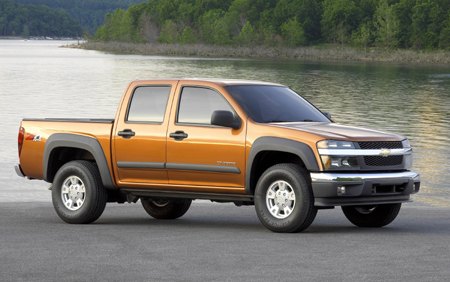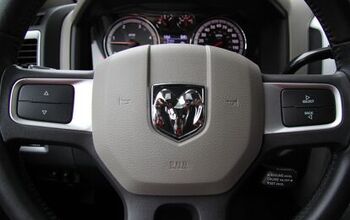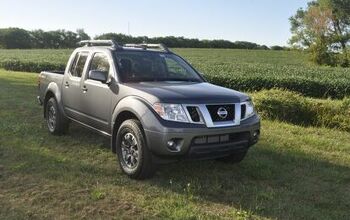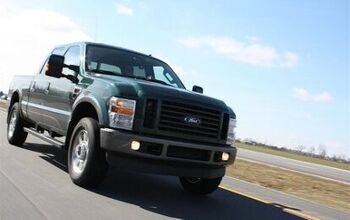Chevrolet Colorado 4X4 Crew Cab Review
For once, the brochures are right: nobody in their right mind buys a small truck for motoring pleasure. A small pickup is a way to get to and from outside activities, like kayaking, rock climbing, schlepping a DLP TV, fencing in the back forty, running a few bales of marijuana across the Mexican border (closed course, professional driver), etc. While full-size pickups mollycoddle their drivers in the hopes of luring owners who don’t actually need them, their smaller siblings have stayed true to the genre’s hair-shirt-on-leaf-springs roots. But even at the low end, there is a hierarchy….
Aside from the imminently breakable, fake chrome plastic decoration across the front (begging for aftermarket machismo) and the resulting insectoid bisected headlights, the Colorado is a decent looking truck. There’s no deference to the wind tunnels, and isn’t trying to Dodge pickup protocol with a sheetmetal ode to eighteen-wheelers. The Colorado’s squared-off, almost military lines are kinda cool, in an old school hardware store sort of way.
The interior is exactly what you'd expect: basic, functional, plastic. Our test truck was a four-wheel-drive crew cab (four door). If you called shotgun too late, this is the version you want. While most small pickup’s rear seats are best suited to small boxes of inanimate objects, the Colorado crew cab’s back chairs are spacious enough for two six-foot humans.
The Colorado’s double-walled bed is as unadorned as the obelisk in 2001. Tie downs? We don’t need no stinkin’ tie downs! (Unless, of course, you do.) In any case, our crew cab provided a 5’1” bed. If hauling is your thing, the standard-issue Colorado's bed extends a foot further, delivering deeper storage and higher overall payload than its rivals. Both beds offer two-tier cargo loading and tailgates that are both lockable and removable– but not at the same time.
The base Colorado holsters a 185-horse 2.9-liter DOHC four-cylinder engine hooked-up to a five speed manual (yay!). Our 4WD Crew Cab came with a 242-horse, 3.7-liter inline five-cylinder mill mated to a four-speed Hydra-Matic slushbox (boo!). The Crew’s odd-cylindered powertrain stumps-up plenty of stump-pulling power, but those 242 ft.-lbs. of twist arrive with all the alacrity of Santa Claus to a two-year-old.
It’s the damnedest thing. You put the Colorado in drive, mash the gas and go nowhere. Seriously: the engine revs up and truck stays put. The delay lasts [the better part of] a second, but it’s enough time to wonder whether you’ve done something wrong; placed the transmission between N and D or brushed a hidden switch that takes the Colorado from four to no wheel-drive.
When the drivetrain finally pulls out of the station it performs adequately, in terms of moving the truck. But the Colorado’s fuel efficiency is like my fantasy golf game: sub par. The Crew Cab Colorado’s EPA-rated at 15/20 mpg. Hello? The Silverado’s 315hp, 5.3-liter Vortec V8 clocks in at 16/20 mpg. Although the Colorado's fuel efficiency is class average, and you can always opt for the more frugal four, you'd kinda hope for better. Or a V6.
Anyway, in normal driving, acceleration is more-than-merely adequate. BUT… in passing situations, the transmission steps down, then steps down again, in an entirely disconcerting way. There is a big ole gap in the tranny’s understanding of your desire to get past that New Beetle and the amount of time available for the job.
The Colorado’s handling is surprisingly good, especially in Z71 trim (Insta-Trac on-the-fly 4X4 command buttons, front underbody shielding, gas-charged monotube shocks, jagged tires and stickers). The wee beastie corners evenly, without drama. And the Colorado’s independent front suspension and front torsion bars deliver a ride that ain’t half bad– for a truck. It appeared off-road worthy, though we didn’t get a chance to play scrabble for purchase.
The Colorado is what I call a Gap truck. The pickup’s seats have ample space between your bottom and the floor. The gaps in the wheel-wells leave room for meatier tires and plenty of turning radius. It’s remarkably easy to twist the Colorado through a gap in between Prii at Target. And then there’s that lovely gap between its price and the sticker whacked on its full-sized brethren.
But then there is that other gap; the one between the Colorado and its competition. While the small[er] Chevy has antilock brakes, tire pressure monitoring and air bags aplenty, other small trucks are similarly appointed AND they respond better all the way around. Their center consoles click when you close them. Their gear selectors need only half the distance to effect a change. And they go when you want them to.
At the right price you could ignore the Colorado’s Crew Cab’s thirst and mechanical laziness. But anyone who does so rewards incompetence, and pays the price at the pump.
More by Michael Martineck
Latest Car Reviews
Read moreLatest Product Reviews
Read moreRecent Comments
- Formula m How many Hyundai and Kia’s do not have the original engine block it left the factory with 10yrs prior?
- 1995 SC I will say that year 29 has been a little spendy on my car (Motor Mounts, Injectors and a Supercharger Service since it had to come off for the injectors, ABS Pump and the tool to cycle the valves to bleed the system, Front Calipers, rear pinion seal, transmission service with a new pan that has a drain, a gaggle of capacitors to fix the ride control module and a replacement amplifier for the stereo. Still needs an exhaust manifold gasket. The front end got serviced in year 28. On the plus side blank cassettes are increasingly easy to find so I have a solid collection of 90 minute playlists.
- MaintenanceCosts My own experiences with, well, maintenance costs:Chevy Bolt, ownership from new to 4.5 years, ~$400*Toyota Highlander Hybrid, ownership from 3.5 to 8 years, ~$2400BMW 335i Convertible, ownership from 11.5 to 13 years, ~$1200Acura Legend, ownership from 20 to 29 years, ~$11,500***Includes a new 12V battery and a set of wiper blades. In fairness, bigger bills for coolant and tire replacement are coming in year 5.**Includes replacement of all rubber parts, rebuild of entire suspension and steering system, and conversion of car to OEM 16" wheel set, among other things
- Jeff Tesla should not be allowed to call its system Full Self-Driving. Very dangerous and misleading.
- Slavuta America, the evil totalitarian police state





































Comments
Join the conversation
The Colorado is a decent truck with the right bits. The four-banger produces a class-leading (for a base engine) 185 hp @5600 rpm and a good 190 pound-feet of torque @2900 rpm. That means getting the four-banger up to max horsepower requires less revving. It reduces towing by a thousand pounds and hauling by a bit as well, but compensates with much better fuel economy for 2008 at 18/24 mpg. Oddly, I looked at a couple at Carmax today alongside the new and old Tacoma and Ranger, and found base models to feel more comfortable than higher levels. For example, the split-bench front seat has a cloth center armrest, while the captain's chairs have a plasticky center console. I would seriously consider the split bench for that reason, not to mention it can (conceivably) seat six people. A few things to consider that haven't been mentioned yet: This truck did badly in IIHS side-crash tests. Structural strength was particularly poor. Don't buy this truck without side-curtain airbags, at the very least. If they come out with torso airbags at some point, get those too. This truck gets electronic stability control standard for the first time for 2009 MY, making the new model years less likely to roll over. The Colorado Crew Cab with four-cylinder engine costs virtually the same amount as a Toyota Tacoma Access Cab with four-cylinder engine. It delivers economy within a mile per gallon of the Taco. The Chevy is extremely small and light: It's much smaller than the Tacoma and Frontier, especially in width. It is not meant for those looking for a small full-size. In short, I think that the Colorado can be a good truck for some people if they check the right boxes, especially because it's the only compact truck that is available with a four-cylinder crew cab configuration.
I think that Canyon does not lose so much with competition as with market timing , politics and dishonest , incompetent professional reviewers . When introduced in 2004 it was big hit with its 225 hp I5. In 2005 Nissan and Toyota introduced their new Frontier and Tacoma. Road- comparisons tests were made ,test data published , opinions formed and impressions made. Competition turned out to be stronger. I 2007 Canyon came up with bigger ,stronger , updated engine 3.7L I5. It was too late and too little to regain reviewers attention like Edmunds, CarAnd Driver or Customereports.org. By 2007 Tacoma and Nissan 4.0 L V6 were already taken for granted so market timing was really bad for Canyon. Certainly Canyon is not Tacoma or Frontier but relaying on 2005 performance results in 2009 Canyon reviews and ignoring fact that Canyon has new much better engine is simply crossing the line especially by Customereports.org which still quotes performance numbers for Canyon's old engine. On compact truck market totally dominated by Toyota and Nissan, Canyon 3.7 L I5 never got a second chance to be tested against Frontier and Tacoma. Too bad since Canyon has really strong engine, maybe somewhat crude and unrefined but definitely powerful . Impression that 3.7 L I5 feels a bit sluggish can be misleading since all torque engines feel slow no matter how strong they are and dead feel of aluminum block make things even worse. My Canyon is 2WD Regular Cab 3.7L I5 and it definitely accelerate faster than my 2005 Honda Accord V6. Fair to say it is also light truck below 3500 lb. As far as measurable Canyon performance I found only two credible information. One is coming from TestTruckDigest @GolfCoastNews.com They tried comparable Canyon and Tacoma and they got identical results for 1/4 mile and Tacoma being minimally faster at 0-60 test. Second result is coming from Dragtimes .com. Sure this is not professional site but tested are done by car and truck enthusiasts and as far as I know this is very honest and honorable site with guys having no business in fixing results . Toyota flagship technical marvel 2008 Tacoma X-Runner went about as fast at 1/4 mile and 0-60 as 2008 GMC Canyon , fact that Canyon had modified module for using higher grade gasoline but stock Tacoma use top grade gasoline anyway. Is it a joke or what ??? I was offered to buy workhorse like this for 14600 extended cab power everything ,nice alloy wheels, at bankrupting GMC dealers. How much X-Runner cost ???. I bought my truck for 12139.99 , how much basic Toyota 4 bangers cost with optional air conditioning ??? Close to 20000 !?. Sure Tacoma and Canyon are priced about the same but only on the paper .Enough said. Also ,to be correctly understood , my post relates only to Canyon engine performance not to overall rating of the vehicle.